From freelance language consultant to in-house scientific writer
Written by Claire Bacon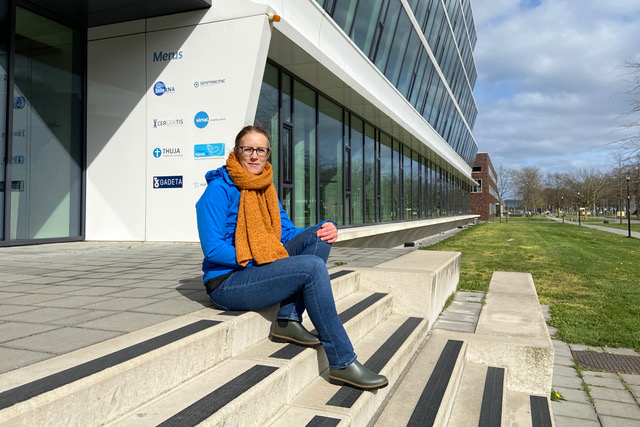
Although many SENSE members are freelancers, this is not always the case. SENSE member and former freelancer Sally Hill has just started a new in-house job at an international biotech company. Claire Bacon caught up with her in the week she made the switch.
You are starting your new job as a scientific writer on 1 April. How long have you been working as a medical and scientific writer and when did you realize you wanted to make this your full-time job?
When I set up my business 13 years ago, it was initially as a freelance Dutch-English translator in the life sciences. I soon felt confident enough to offer editing as well, and through SENSE I got involved in teaching scientific writing. It wasn’t until about six years ago that I first started getting writing assignments too – from the same company I’m now moving to. The scientific reports I write for them are quite technical and nerdy, and right up my street. This encouraged me to look for similar clients, and I discovered the world of medical writing and the European Medical Writers Association (EMWA). Through this professional network, I realized that medical writing might be better suited to my science background.
But it was only recently that I thought of taking up this client’s offer of a part-time contract –previously, it would have been near impossible to schedule my teaching activities around fixed days at an office. Various things came together over the past few months: teaching for two of my university clients came to an end; all my other teaching went online because of the pandemic and the increased screen time was giving me back and neck issues; plus, my husband was thinking of going freelance himself. For financial security, we decided one of us should be on a fixed contract, and I was ready for a change!
I imagine the skills for medical and scientific writing overlap a little with those for medical editing. What makes you more suited to writing rather than editing?
When I write for scientists, they really appreciate my critical questions and attention to detail – in other words, the aspects that made me rather a slow editor improve the quality and consistency of their documentation. When editing, I probably take too much time looking up references and researching the topic of a research paper I’m editing – often purely out of interest in the science, which I think I’ve probably always missed. But of course, my experience as an editor makes me a much better writer. And now I have a junior writer to help train up, for which my teaching experience will also come in handy. Win-win!
Did you do any special training when you transitioned to medical writing, or did you learn on the job?
It was mainly on-the-job training. In general, scientists become familiar with scientific writing during their master and doctoral studies, so it’s not something you need training in if that’s your background. And that’s where the scientists at the company ‘learned’ to write – not that their English is perfect, but for internal documentation that’s often less important. Of course, after I started offering scientific and medical writing as part of my business, I made sure to brush up my writing skills where possible by attending relevant webinars and workshops. I attended EMWA’s virtual conference last year and hope to go to the next one in May.
What advice would you give anybody who wants to move into medical writing? Does it help to work as an editor first?
Being a science editor certainly gives you a head start. But many medical writers are not native English speakers, and many have no formal language skills or training. Apart from the scientific writing that I do, medical writing can also include things like translation, statistics, regulatory writing, project management, marketing and copywriting. You don’t necessarily need specific training, but from what I can tell it can be hard to get a job without a bit of experience. Many people work in a related field before applying for a medical writing job.
EMWA offers lots of training workshops at their twice-yearly conferences and their website has a wealth of information and resources, including a useful Career Guide to Medical Writing. You can also join the Netherlands Science and Medical Writers Network that I helped set up with other freelancers. We have private groups on Facebook and LinkedIn where aspiring and experienced medical writers – both freelance and in-house – can ask questions, share resources and post jobs.
You are going to be working for Merus in Utrecht. What attracted you to this company?
Before making this decision, I did think carefully about whether we were a good match. Before the first lockdown, when I was still freelancing for them, I was going into the Merus offices once a week. Attending meetings and eating lunch in the staff canteen improved communication in general and helped my ‘colleagues’ know who I was. This also gave me a pretty good feel for the company and the people who work there. My gut feeling says they care about their employees; they pay them well and morale is good. I also really like the international feel of the place – they also have offices in the US and the staff are from all over.
What will you miss most (and the least!) about being freelance?
I think I’ll probably miss the camaraderie of my freelance colleagues. As a freelancer, networking has become second nature and I can get a real kick out of making connections with others, even if I don’t necessarily know whether it’ll bring in new work. Of course, I can still stay connected with others and continue to expand my network, but it won’t be part of my working day anymore.
What I won’t miss is the admin! I tend to put off my quarterly tax returns, and the paperwork can really pile up towards the deadline. And, of course, I won’t miss the uncertainty of being my own boss, and the pandemic has brought this home to many of us. While I was fortunate to see no drop in income over the past year, the idea that I no longer have to keep an eye out for new clients in case current ones let me down is very reassuring.
Everyone will want to know whether becoming a full-time medical writer means you are leaving SENSE! Do you plan to stay involved with the Society? And do you think scientific and medical writers can benefit from SENSE membership?
It really hadn’t occurred to me to leave SENSE! Of course, I’m no longer a freelancer and I’m no longer translating/editing/teaching. But that doesn’t mean I don’t need the expertise of SENSE colleagues or that I am no longer willing to share my own. I’ll have Fridays off and so will still have a few hours a week left for my various bits of voluntary work (including SENSE) and for my one-to-one coaching clients.
In terms of what the Society can offer to scientific and medical writers, I recommended SENSE to an aspiring medical writer only last week. This non-native English speaker with a science PhD wanted help in developing writing skills before applying for writing jobs. I recommended that they join SENSE and team up with a mentor to get feedback on their writing. I know of no other organization in the Netherlands that offers a similar mentoring programme. In that respect, SENSE really is an ideal association for professionals in the Netherlands looking for support in developing their English language skills.

Hear the term ’compliance’ and most of us in the language business (or any business) will shrink a bit – especially when it’s tied to an acronym like ’GDPR’. This refers to the General Data Protection Regulation which represents the legislation passed by the European Commission in 2016 to update what has been an evolving policy on protecting the private information of individuals living in the European Union. This set of regulations was activated in 2018.
Though it might seem applicable only to big companies and online commerce, it applies to anyone conducting business in the EU, including freelance language professionals. If you’re not safeguarding the personal data that has been coming across your desk, it’s time to start wrestling with that hidden beast.
Luckily, Steven Segaert has been studying the beast and its implications for language professionals. Steven is a freelance English–Dutch translator and a lawyer based in Belgium. At the recent Tech SIG he summarized it thus:
’Know what you have, and why you have it’ and ’limit as much as possible’ what you have.
Steven led us through a methodical process we can apply to identify and protect relevant information we may have. Describing first what personal data actually is, he then introduced how to do a data mapping exercise to understand what you have and how to categorize it.
This obviously can get complex if you are a large entity such as Google or bol.com; for freelance language professionals, Steven noted, it ‘is not terribly difficult…but there are chances we are doing things that are not totally okay.’
The intention of the GDPR is to limit the processing of personal data to only what has a legitimate business purpose, to the least extent possible, and to ensure that you are transparent about what you do and accountable for how you protect the data. The important thing is that you can reasonably explain why it is necessary to process the personal data in your possession – for example, to market your services, or because you are legally required to keep records for a specified number of years.
Once you’ve trapped your beast, you need to know how to take care of it. Security was not discussed at great length, but the lively Q&A touched on email, translation memory, and the horror of a lost (or stolen) laptop.
Accidentally losing your laptop in a café or on the train doesn’t have to be a GDPR disaster in addition to a work disrupter – but it can open you up to risk if you have not documented (elsewhere) what personal data was on the laptop and how it was secured.
GDPR compliance can be a complex undertaking, but setting aside some time for it, you will, in Steven’s words, ’already be doing more than 90% of freelancers’ in capturing and taming your personal data beast, and protecting yourself and your clients from risk.
Steven’s bracing and thorough presentation got us all talking about our workflows in a new way, and suggested some new approaches to our business and technical systems.
Julie Uusinarkaus on revising translations: let it (mostly) be
Written by Maris van der Laak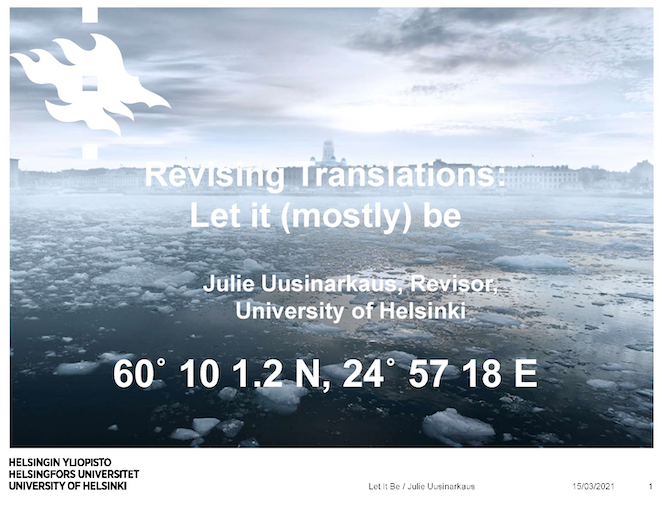
The meeting was convened by Joy Burrough-Boenisch, who welcomed the 29 members who attended the Zoom meeting. Joy introduced the speaker, Julie Uusinarkaus, who works as revisor at the University of Helsinki.
Julie started her presentation with a picture of ice floes in Finland and explained that she works as in-house revisor, academic editor and freelance design editor. The revision at the university involves translated material, very often fairly routine texts such as university regulations, curricula and news releases etc.
There are four in-house translators (Finnish native speakers) and up to ten freelance translators, working as a long-standing team. The official languages of the university are Finnish, Swedish and English, and no language is supposed to take precedence.
Julie explained the revision process, which she described as relatively simple. The team works in a bilingual Trados interface – we were shown a specimen screenshot of a translation. The translation first comes from the translator, and is then revised by a second translator and a revisor, who carry out two quality checks. The first, done by a second translator, is of the facts and translated vocabulary. The second quality check, which is done by the revisor, is of the readability of the text as a whole from the viewpoint of a native speaker. The original text must be followed as closely as possible and the aim is to have a clear text in the style of the university. The text is then returned to the original translator. A record is kept of all the points of discussion and any compromises. The author has final authority over the text.
The university translation team has its own in-house style; certain stylistic points have been the subject of discussion before agreement was reached, eg, representation of telephone numbers, 24-hour clock and commas after 'e.g.' and 'i.e'.
Julie introduced a number of examples and held a poll for each. The results of the poll were particularly enlightening for us and for Julie. We were given two versions of the translation of a Finnish text and the original Finnish text. Julie pointed out the query points and we could choose which of the two versions we would opt for. Do we accept the edit? Does the edit change the original Finnish meaning? The examples led to a wealth of comments and suggestions in the chat. The last example introduced 300 elk incisors and a garment, and we were asked whether the structure of the sentence should be changed and whether the word 'decorated' or 'attached' was more appropriate. It was illustrative of Julie's presentation and became the subject of a particularly interesting and lively discussion - online, of course.

Most of us occasionally have to move our work to a new computer. In this article, I will give you a few tips on how to get started. However, the information is limited to PCs running Windows.
As an aside: the benefits of keeping your data on an external drive
Your PC has an internal hard disk drive (formerly a 'spinning rust' disc, now usually a Solid State Drive (SSD)). This contains the Windows operating system, program files and data. Although you could store your data (work, email, admin, etc) on the internal disk, I've always found it easier and safer to use an external drive. Therefore, whenever I have to take the PC in for repair, I can leave the external drive at the office, so I won’t have to worry about the repair shop having access to my data. When I go on holiday, I put the external drive in a safe; a burglar might walk off with my PC, but not with my data. This approach also makes it easier to comply with data protection legislation.
An external drive also makes it easier to move to a new PC: once you have set up all the software, you simply connect the external drive and continue as before. So, if you are not currently using an external drive for your data, moving to a new PC might be a good time to consider getting one!
Preparation
The first thing to do is take a close look at your current PC: what do you like about it and what could be improved?
Next, make a list of all the software you use and review that critically. The easiest way to get a full list is probably to go to Windows Settings > Uninstall or to Settings > Apps & Features, depending on the version of Windows you use.
Go through the list and see what software you actually use and need to install on your new computer. If the software is covered by a licence, you may be able to deactivate it on your old computer and then activate it on the new one. The relevant process is different for each software package.
Can you download the software on your new PC, or do you need to install it from a CD? If you are moving to a new version of Windows, you will have to check that your new computer is compatible with older software.
How you migrate your emails to the new computer depends entirely on the email software you use. If you only use web mail or another server-based email client, this will not apply to you. Now might be a good opportunity to consider if you want to keep working that way. You may also want to copy your browser bookmarks to your new PC.
This might also be a good opportunity to decide if you want to move to new software. For example, I moved from Adobe Photoshop to Affinity Photo: cheaper and available under a perpetual licence rather than a subscription.
Remember to make notes of the languages, keyboard layouts and other Windows settings you use. Do you want to keep the current drive letter assignments (eg, C: for programs, D: for data on the internal disk, G: for date on the external disk) or start afresh on your new PC? How do you back up your data, and do you want to continue using that method? Will you need to be able to restore old backups to your old PC? If so, do you need specific software or perhaps an optical drive?
Setting up your new PC
- Set up Windows and take a critical look at the security and privacy options. Being a paranoid Luddite myself, I've turned all the 'cloudy' functions of Windows off.
- Set the Windows keyboard and language options.
- Set up user and administrator accounts. Running Windows as a user rather than an administrator has some security advantages.
- Set up drive partitions and assign drive letters, using Windows Disk Management.
- I would advise making notes on paper of the most important settings, user names, passwords, etc and storing those in a secure place.
- The next step is to download and install all your software and activate licences where relevant.
Pro tip: if you find that Windows suddenly switches to a different keyboard while you're working, you may accidentally have pressed Alt + Shift. Press those keys again to switch back to your normal keyboard, or look for the keyboard box in the task bar at the bottom of the screen.
Every time I install new software, I also check that all my other important software still works and is not affected by the most recent software installation. If older software does not run under Windows 10, you can investigate the options available to you. If you right-click on a program and select Properties, the Compatibility tab will show you the available settings. Another option is to get advice from a computer wizard!
Moving your data to the new PC
Make sure your antivirus software, etc is operational. Connect the external drive containing your data to the new PC. Change the drive letter if necessary, then check that all the software works with it.
If you do not normally use an external drive for your data, you can use one temporarily to transfer data between the internal drives of your old and new computers. Alternatively, you can use cloud storage or an online service such as WeTransfer.
Creating resilience through installing alternative software
Software such as MS Office 365 and Adobe products is dependent on an active subscription, and regularly 'calls home'. That means that if something goes wrong with your account, or if you have extended connectivity problems, the software may simply stop working. At present you can still get MS Office under a perpetual licence, which avoids those problems.
If you normally use Adobe Acrobat to read PDFs, you may want to consider an alternative, such as Sumatra. I prefer that because it is nicely spartan and does not have automation features, which could create security issues if somebody sends you a dodgy PDF.
I have also installed LibreOffice on my PC. The software package is not dependent on a licence server and should always work. It is largely compatible with MS Office, and Libre Office Writer can apparently open some damaged Word files, should MS Word encounter any issues.
Notepad++ is a useful editor for opening any file and accessing data files for software which is no longer available.
Windows 10 does not include DVD playback software. VLC Media Player seems to be a good option and is free.
Last, but not least...
Before you start using your new PC in earnest, it would be a very good idea to test your backup and restore arrangements.
I hope these notes are of some help to those who have to move to a new PC. If you have any questions, then you may want to set up a thread on the SENSE forum. And of course, you’re always welcome to join the next Tech SIG meeting!

Editing is an ever-changing industry. To stay competitive, language professionals must continuously develop and hone their skills. There are many opportunities for continuing professional development (CPD) out there, but finding time for it can be tricky. In this post, I take a look at the different kinds of CPD and suggest how to make time for ongoing learning.
Virtual meetings
Conferences are a great way to find out what is new in your industry and to hone your skills. The pandemic has forced many conferences to move online, meaning you can now attend from the comfort of your own home (goodbye travel expenses!). Although we were disappointed not to be able to meet in person, I think we would all agree that SENSE 2020 was a big success. And those of us who attended the Chartered Institute of Editing and Proofreading (CIEP) 2020 conference were similarly impressed with the quality of the sessions and how well the conference had been adapted for an online audience. A big advantage of online conferences is that the sessions are often still available after the event, giving attendees plenty of time to catch up on anything they missed. So why not attend an online conference this year? Here are some examples of what’s on offer:
- ACES: The Society for Editing conference on 22–23 April
- CIEP conference on 11–14 September
- Mediterranean Editors and Translators (MET) conference on 14–15 October
- European Association of Science Editors (EASE) conference on 23–24 June.
Specialist training
Training courses are a good way to develop your editing skills. Once you have mastered the core skills, you can start to look for more specialist courses that interest you or are relevant to your work. I edit scientific research papers, so after completing some general copyediting training, the CIEP’s Medical Editing course seemed like a good place to refine my skills. Although some of the course content (such as the academic publishing process, and structure and format of standard research articles) was familiar to me after working as a research scientist, the course was invaluable because it taught me how to approach editing scientific texts methodically and be a more efficient editor. It also highlighted common style issues in medical editing. This specialist training raised my profile as an editor and helped me land jobs as a copyeditor for two medical journals.
Reading
Reading books that are relevant to your niche is an easy way to fit valuable CPD into your busy schedule. Books on academic writing give valuable insights into how I can better help my clients with their research writing (They Say/I Say by Gerald Graff and Cathy Birkenstein, Writing Science in Plain English by Anne E. Greene, Give Readers Nuggets by Ed Hull and Writing Science by Joshua Schimel are some of my favourites), while books about copyediting in general help to identify areas I need to work on (for example, Carol Saller’s The Subversive Copy Editor motivated me to make my editing more efficient by learning how to use Word’s features. Thanks to the CIEP’s course on Word for Practical Editing, I now use macros daily to speed up my editing).
Finding the time
One obstacle to CPD is finding the time to do it. Scheduling regular CPD time around your usual editing/translation work can help; perhaps an hour every morning for reading, or half a day a week to work through an online course. An accountability group of like-minded language professionals can help to keep you on track with your CPD goals.
If, like me, you suddenly found yourself spending hours every day home-schooling small children, taking an online course or scheduling time for reading might seem laughably unrealistic! Thankfully, there are easier ways to squeeze valuable CPD into your busy schedule: listening to podcasts while doing the ironing or spending time interacting in online groups, for example. Scrolling through the Editors Association of Earth Facebook group is a great way to find solutions to problems you didn’t know you had, and The Editing Podcast by Louise Harnby and Denise Cowle is crammed with useful information for writers and editors.
If you have any additional tips for effective CPD, share them in the comments below!
Let's get started: how-to guide for new SENSE members
Written by Anne Oosthuizen, Martina Abagnale and Danielle Carter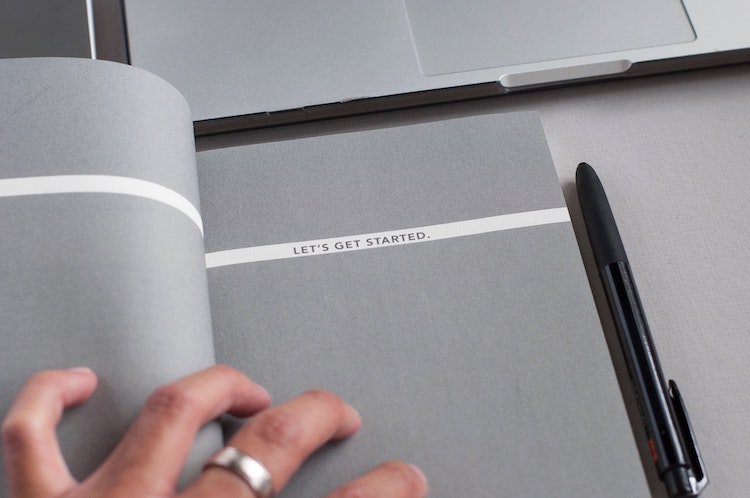
Welcome to SENSE, the Society of English-Language Professionals in the Netherlands! SENSE is a professional network for language professionals working in, into, or from English; English is our working language, but we’re happy to have you if your native language isn’t English or if you live outside of the Netherlands. Anne Oosthuizen, Martina Abagnale and Danielle Carter, the co-conveners of the Starters SIG (we’ll explain what that is below), have written this blog post to help you navigate SENSE as a new or soon-to-be member. Welcome!
Let’s jump right in: how should you get started when you join SENSE? And how can you get the most out of your SENSE membership? There’s a wealth of resources and information available via the SENSE network, so it can be a little intimidating trying to navigate it all – this guide will help you get started.
Joining SENSE
In case you haven’t already joined SENSE, you can find more information about becoming a member here and register to join SENSE.
Staying up to date
You can add the SENSE blog to your RSS feed. Once you become a member, you will also receive a newsletter with updates about new blog posts and membership-wide events. You can also follow SENSE on Twitter, join the closed SENSE LinkedIn Group, follow the SENSE LinkedIn page, and join the SENSE Facebook page.
SENSE also wants to hear from you! If you have a blog, SENSE will help to advertise your posts by occasionally sharing them on social media and in the newsletter. To notify SENSE about your blog, send an RSS link to media@sense-online.nl.
Special Interest Groups (SIGs)
The best way to stay tuned is to subscribe to relevant groups on the forum! SIGs are small, members-run subgroups within SENSE that cater to specific fields of interest, topics or regions. You can find a list of all the SIGs here.
You’re welcome to attend events from SIGs that you’re not subscribed to, and also feel free to attend, for example, Southern SIG events even if you live in Groningen (or Spain). Keep an eye on the calendar to find events that may be relevant for you.
Starters SIG
The Starters SIG is specifically geared towards people who are just getting started in the language industry or people who are changing paths within the industry. We organize monthly events on a variety of topics relevant for us; for example, finding initial clients, setting rates, or freelance marketing.
Forum
You can subscribe to any SIG on the forum to stay updated on their activity. In addition to a category for each of the SIGs, there are also various categories for different issues or interests. You can subscribe to a category and receive an email update for each new post by clicking on any category and then hitting “Subscribe” in the horizontal bar above “Subject.”
Some of the most important categories for getting started are Jobs (where SENSE members can post job opportunities), Professional Practice (a place to discuss some of the nitty gritty of work as a language professional), Resources (where members post resources that they’ve found helpful) and the Starters SIG group. You can also add a browser bookmark to the most recent topics so that you can check in on the latest posts in categories you’re not subscribed to.
The very first thing you should do is introduce yourself on the Introduce Yourself section of the forum.
Professional development
In addition to SIG events and the forum, the Best Practices handbook, the mentorship programme, the SENSE conference on alternating years with the Professional Development Day (see the calendar) all provide opportunities to develop your professional practice and advance your career.
You can also volunteer for SENSE, which is a great way to put yourself out there and get to know the many wonderful language professionals who are SENSE members. You can volunteer by setting up a SIG, joining a SIG as a co-convener or by helping with social media or event planning, for example.
Again, keep an eye on the calendar for other professional development opportunities! SENSE regularly hosts workshops and events.
External resources
You may have also noticed a few non-SENSE events on the calendar. The calendar is updated with other language-related events and conferences, and SENSE has a few sister organizations, which also host events and produce content that may be relevant for you.
Hot tip: It may seem funny to look into these other organizations, but you can find a variety of different events, networking groups etc and get a discount at SENSE’s sister organizations if you’re a SENSE member, so go on and see if there are relevant things happening in these organizations too!
In addition to SENSE’s sister organizations, you may also want to check out the Vertalerskoffiehoek (a Dutch-language translators Facebook group, which many SENSE members are a part of and which hosts a weekly co-working session), the Editors Association of Earth Facebook group, and the BP Translation conference (which hosts regular professional development events for translators).
If you’re still feeling a little lost or overwhelmed, get in touch! Post your question on the Starters SIG forum or email one of our conveners. We’ll help you find the way.
UniSIG meeting report: Lisa Muszynski on the University of Helsinki’s Language Services
Written by Tanya Barben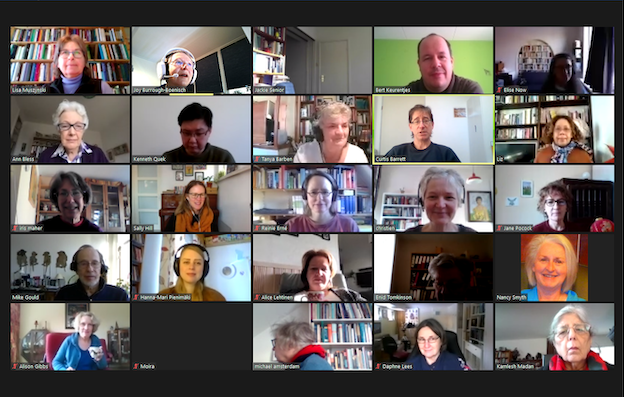
The 12 January UniSIG meeting was convened by Joy Burrough-Boenisch, who welcomed all 29 attendees and introduced the speaker, Lisa Muszynski, language revisor at the University of Helsinki. Also present were five non-SENSE members: two from Finland, two from South Africa and one from the Netherlands. South African visitor Tanya Barben, member of PEG, reports:
Lisa explained that the term ‘revisor’ (rather than ‘reviser’) is used to describe the person responsible for revising the English (one of the University's three official languages) of the over 60,000 texts processed annually by staff and freelancers working for the University’s Language Services (the ‘unit’, hereafter). These texts comprise abstracts, articles and books whose publication is anticipated, as well as doctoral theses. The revisors also check the acceptability and fidelity of texts translated into English. They are encouraged to use tracked changes and margin/bubble comments, and any interaction with the client is generally via the easier email rather than by phone.
The revisors establish whether the arguments presented are logical; the focus is on grammatical and linguistic accuracy as well as reader comprehension. In the case of articles and books, their aim is to get the work to publication standard (although some emendations might be necessary following the peer review process). Essentially, the unit’s purpose is to improve the text’s quality and fluency, to get the client’s ‘foot in the door’ for academic publishing, and to cede the final responsibility for the text to the client.
The freelancers are given guidelines and a list of reference works and citation styles (including clickable links to some) they are expected to be familiar with. Prior to the pandemic, there were meetings and in-person training sessions. Not all the freelancers have academic qualifications, but some are very experienced and some better than herself, Lisa suggested. All are native speakers of English and are expected to have passed a test based on the worst paper ever received by the unit.
There is a coaching element to what the freelancers and Lisa do. They address lexical problems via comment bubbles and, where necessary, suggest alternative, more natural-sounding sentences; clients have an opportunity to indicate exactly what they want to say.
Of course, there are limitations to what the revisor can do. In all instances, it should be made clear that any changes are not editorial interventions but rather suggestions that the client can accept or reject. There is a need to recognize that the needs of clients may differ. Revisors should also maintain a balance between revision and editing and be aware of the difference between content and style.
A staff member of the unit liaises with the clients to obtain any feedback. Complaints are rare. The clients are responsible for their texts (and for any plagiarism) and for getting them published.
The meeting lasted about 60 minutes. Attendees participated fully and some of the many questions asked form part of the above account.
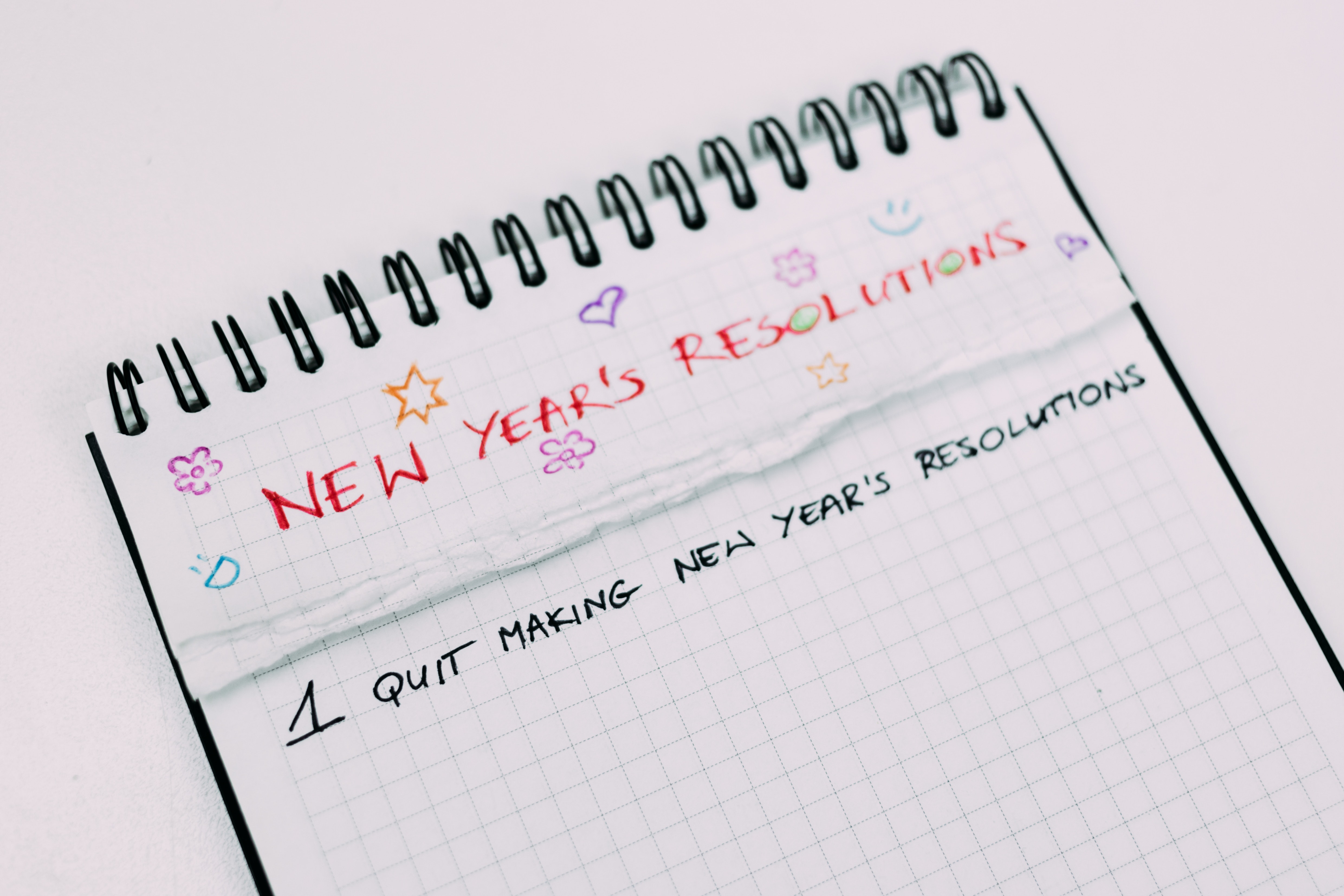
The first Starters SIG of 2021 revolved around our New Year's resolutions. As everyone came in, we spontaneously started off with tricky T's & C's and the pain of insurance policies. But that’s the beauty of this Starters SIG: all questions are welcome!
After briefly discussing what to look out for (your legal liabilities) and concluding insurance policies are worth thinking about when starting out (especially in legal translations), our hosts Danielle Carter, Martina Abagnale and Anne Oosthuizen introduced the evening's theme: our goals for the new year.
I was immediately reminded of why I've been enjoying these meetings: a lot of us go through (or have gone through) the same thing. There is always someone who shares a similar story, to encourage you or provide some timely advice. For example, one of my own goals for 2021 – expanding my copywriting skills – was in fact inspired by other SENSE members. They recommended the copywriting course from the College of Media & Publishing, and I’m happy to say I’m on track to graduate in May!
Another regular topic at the Starters SIG is finding new clients, and how to go about approaching them. LinkedIn is a popular place to go, as are other social media. The main idea is: you have to be where your (potential) clients are, and engage with them there. One member even snatched her dream client by following them for a very long time until eventually they approached her!
It looks like the Starters SIG is full of plans for the new year. Some of us are just starting out, wanting to find our first, second or third client. Others are looking to expand or rebrand, and it was really inspiring to hear everyone share a bit of their background as a way to move forward through the new year. And the best news is, you can join a first meeting or two even if you’re not a SENSE member yet! Keep an eye on the Events calendar for more information.
We now have a room full of so-called accountabilabuddys – ready to tackle 2021!
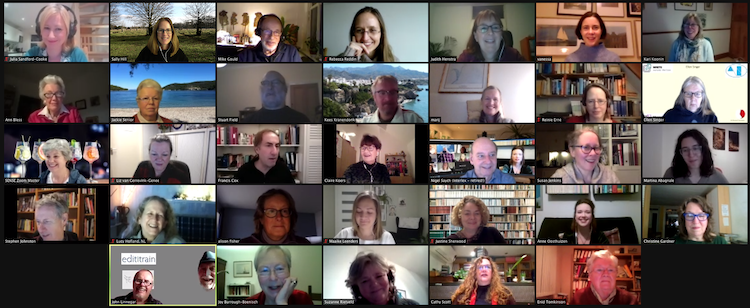
How do you move forward from a year like 2020? By having a few drinks with fellow editors and translators of course! On 8 January, SENSE organised its annual (and my first) New Year’s Borrel. What follows is a recap by newbie borrelaar Maaike Leenders.
To borrel or not to borrel
Let me start off with a little confession: I rarely do ‘borrels’. I can’t help imagining a room full of strangers trying to chit-chat, wondering why on earth I opted for heels instead of sneakers.
I’m glad to say this was different!
First of all, we met up online. This turned out to have some substantial benefits:
- People joined from all over the world, including those who couldn’t have attended a live event;
- The breakout rooms made it easy to ‘mingle’ with different people;
- Fun backgrounds (hello, giant cocktail glasses!);
- No heels!
A sense of community
The afternoon started off with a short introduction – of people and drinks – and best wishes for the new year. We continued with smaller groups of about 3–4 people to discuss a topic. Then we promptly forgot about said topic and talked about The Year That Was 2020. Once we rejoined the whole group, there was plenty of room for positivity. For example, did you know SENSE members have very interesting (pandemic proof) hobbies? There’s books and baking, walking and writing, but we’re also learning new languages – even that of horses!
To wrap up the afternoon, our host Anne Oosthuizen organised a book bingo that offered everyone an opportunity to share a bit about their books – and themselves – with the whole group. I’m happy to say my reading list for 2021 is now about twice as long.
An all-around success for sure!
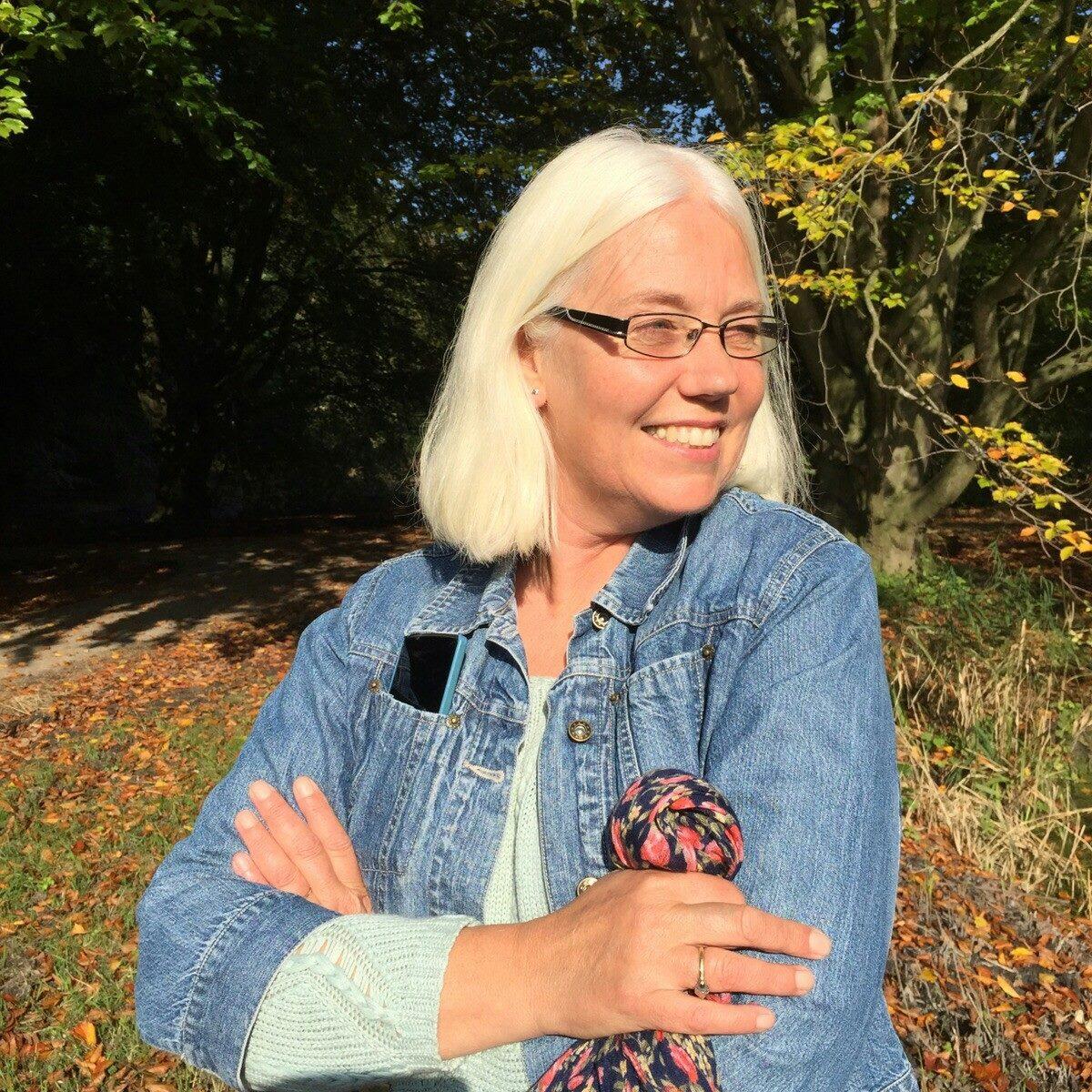
When Carla Bakkum tells people she specializes in financial translation, reactions vary all the way from awe to downright horror. But take it from somebody who has spent over 30 years Swimming with Sharks, the financial world is exciting. Here Carla busts seven common myths about the profession.
You need a financial background to be a word worker in this sector
False. I myself am a case in point. As a Dutch gymnasium student, I was never bothered with something as mundane as economics, and five years studying English at the University of Amsterdam made me none the wiser financially. But when private bank Pierson, Heldring & Pierson came to our professors looking for fresh translation talent, they recommended me, three-times winner of their department’s poetry translation contest. I blithely applied, having virtually no idea what I was letting myself in for, but knowing translation was where my heart lay.
Though I didn’t get the in-house job, the head translator Silvia Zaugg called me not much later to ask if I’d like to work freelance for them. She coached me intensively through my first on-site assignments and unfailingly sent me back the revisions not long after. With the experience I gained, I applied for and won work from ABN AMRO: I was launched as a financial translator. And what got me there? An enquiring mind, a sharp pen and a knack for quickly learning new languages – such as financialese.
It’s all about numbers
False. Financial texts are about the real world, about economic activity in all its varieties. Translating stock market updates, annual reports and press releases means treating yourself to a crash course in anything from beer brewing to baby nutrition, from aviation to nanotechnology, from power plants to solar cells. Some inkling of chemistry and physics is a real help, I find, and can actually give you an edge on the investment writer whose text you’re working on (who has typically studied economics or law). If you enjoy developing a broad knowledge base and learning something new every day, you have the makings of a financial translator.
It’s mind-bogglingly difficult
Sorry, not entirely a myth. Besides developing more than a nodding acquaintance with a myriad businesses, translating investment texts and annual reports means getting to grips with exotic beasts like hedge funds, interest-rate swaps, CoCos, floating rate notes, bear straddles, impairment, EBIDTA, tier 1 ratios…. And just when you think you’re on top of things, financial innovations like bitcoin and blockchain technology come along. Enough to make your head swim! Looking on the bright side, though, Google is your friend, and finance is one of the best-documented fields on the internet. If you do this kind of work long enough, you may actually one day catch your investment writers talking through their hats.
It’s ho-hum boring
False. If the variety and complexity of the subject matter isn’t enough to keep you on an adrenalin high, the tight deadlines will surely do the trick. Nowhere is timely information more a make-or-break factor than in the investment business, and nowhere does news turn stale more quickly. So if you can’t deliver that update the same day or overnight, you may as well not bother. Even then, in the time you need to translate your update, new events may reduce it to toilet-paper status. I was rarely more frustrated than the day I worked flat out to deliver a 2,500-word article, only to be told the next day they wouldn’t be using it and asked to translate a completely new one. On a positive note, I did, of course, get paid for both.
It’s a boom-and-bust business
It depends. There is a sizeable core of financial translation, editing and writing that needs doing whether business is booming or in the depths of recession. Annual reports, for example. But the times when I was translating one IPO prospectus a week are long gone. The 2008 recession had a definite impact on my top line. Over the years, however, my brushes with a range of industries while working for banks enabled me to win business clients outside the financial industry as well. I worked to expand in those areas and on broadening my own offering by venturing into copywriting.
There is no fun in financial translation
False, definitely false! The language of the stock market in particular oozes imagery. What is essentially just a matter of price variations over time is described in the financial pages with a poetic zest that is second only to that seen in sports journalism – perhaps because securities trading, like competitive sports, is an activity where modern humans (overwhelmingly men) sublimate their primordial lust for battle. Stocks can soar and nosedive, markets and profit-and-loss accounts can colour red, and Mario Draghi of the ECB has a Big Bazooka he can fire to defend the euro. Even if you’re not writing for the dailies, your texts are often meant for your client’s clients, and therefore need to be engaging and pleasant reading, a worthy calling card for the organization. The authors are rarely talented writers. Taking their pumpkin and mice and turning that into a golden carriage with six white horses is a significant added value that we, the fairy godparents of communication, bestow on our financial clients.
The financial industry is an evil empire that nice word workers like us should shun
False. Yes, false. Let me start by saying that among the people I have dealt with personally, the #@*hole count was extremely low. Many of my contacts are in-house translators, who are up against the same problems I face, but have to bear the brunt of all the office politics, too. The financial specialists I’ve worked with, barring a few exceptions, are dedicated and decent people. It was a horrifying experience watching the 2008 sub-prime crisis unfold from my particular vantage point as a freelancer and a word worker.
As I see it, the downfall of the mighty banks was perhaps not so much a matter of toxic assets as of toxic jargon. The quants who created the overly complex securities, and the traders who traded them, spoke a language that even their own bosses didn’t understand, let alone the investors who bought the securities. As in the fairy tale of the emperor’s new clothes, nobody dared admit they were clueless – or they preferred to ask no questions as long as the returns were so phenomenal.
As a word worker in this sector, you have the option to either go with the flow or spread a little clarity. I was once asked by a pension fund client to summarize and then translate into Dutch a lengthy ‘explanation’ of hedge funds. It had been given to them by a New York asset manager they had hired to invest in hedge funds on their behalf. One of my most challenging jobs ever! When I’d finished, the text was down to manageable size, readability greatly improved, jargon overload pruned – and the vital bad-news info that had been tucked away in the footnotes was now restored to the body text. A real eye-opener for my client. These days, with the harsh spotlight of public opinion shining more intensely on them than ever, financial institutions need to communicate more clearly, both internally and externally, and many are taking steps in the right direction. They are on the threshold of a much-needed culture shift, and as communication specialists we play a key role.
This article was originally published in eSense 43 (2016).